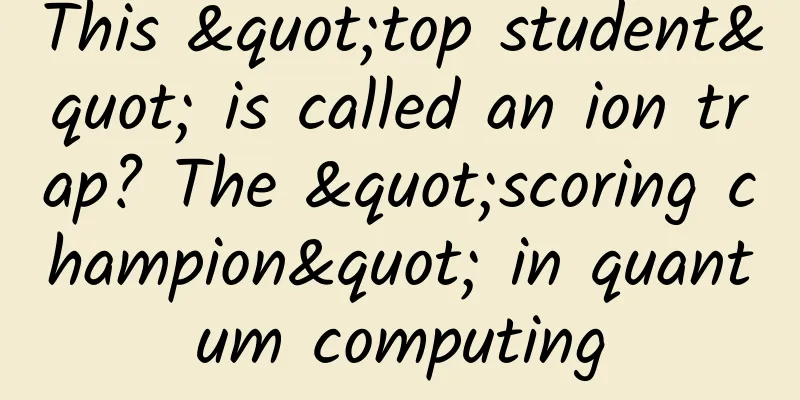This "top student" is called an ion trap? The "scoring champion" in quantum computing

|
Produced by: Science Popularization China Author: Luan Chunyang (School of Science, National University of Defense Technology) Wu Wei (School of Science, National University of Defense Technology) Wang Yutong (PhD in Physics, Tsinghua University) Producer: China Science Expo When it comes to quantum computing, I believe that the first thing that comes to mind is the famous superconducting quantum computing system. However, as early as 1995, physicists Ignacio Cirac and Peter Zoller proposed an innovative method, which is to use stable trapped ions to realize the operation of quantum logic gates and then build a quantum computing system. This is called "ion trap quantum computing." At present, ion trap quantum computing and superconducting quantum computing are considered to be the two mainstream solutions for quantum computing that are expected to achieve real practicality. As the name implies, "ion trap quantum computing" is to stably trap ions in a specific potential well so that they can encode quantum bits and participate in quantum computing. Therefore, "ions" and "potential wells" are the two most core elements of the system, and they are also the key to understanding the working principle of "ion trap quantum computing". Fig. 1 Schematic diagram of ions stably trapped in a potential well. Each white dot represents a single ion, the axial yellow arrow represents the DC electric field, and the alternating green arrow represents the AC electric field. (Image source: drawn by the author) So why do scientists choose trapped ions? What unique advantages does the ion trap quantum computing system have that makes it one of the two mainstream technologies for realizing quantum computing, alongside the superconducting quantum computing system? Let us take these questions and take a closer look at this low-key but powerful ion trap quantum computing system! Ion qubits—tiny bodies, big capabilities In fact, ions are atoms with electric charge, so they naturally have a stable energy level structure inside them. Using this property, scientists can select two specific energy levels inside the ion and encode them into a stable two-level system, which is what we call a quantum bit. For a two-level system in a single trapped ion, we can label the higher energy state as the |1⟩ state and the lower energy state as the |0⟩ state. Since the transition between energy levels within an ion follows the probabilistic principle of quantum mechanics, the energy state of a single ion can be in a superposition of the |1⟩ state and the |0⟩ state at the same time, enabling it to participate in the parallel computing of a quantum computer as an ion qubit. Furthermore, if we can stably trap N ions in an ion trap system, we can theoretically encode N independent ion qubits. Under the precise control of specific laser light fields and microwave fields, these ion qubits can perform 2N-power parallel quantum operations, demonstrating the powerful parallel processing capabilities of quantum computers. Figure 2 Ion chain containing 18 171Yb+ ions (Image source: provided by the author) When discussing the ion trap quantum computing system in depth, we have to mention an important milestone in its development towards scale and integration - the ion transport scheme based on the ion trap quantum computing chip , which is also called the QCCD (Quantum Charge-Coupled Device) scheme. Specifically, the ion trap quantum computing chip is designed to have multiple spatial functional regions, which achieve precise transport of ions between different functional regions by adjusting the composite electric field. These regions are responsible for key tasks such as quantum bit storage, logic gate operation, and quantum state measurement. Through the organic combination of these operations, the QCCD scheme can ensure that the fidelity of each quantum operation will not decrease due to the increase in the total number of ions, which is the key to achieving large-scale universal quantum computing. Figure 3 Ion transport scheme based on ion trap quantum computing chip Schematic diagram of the QCCD scheme (Image source: Reference [2]) It is precisely because of its excellent performance that the research on ion trap quantum computing chips has received continuous investment from Sandia National Laboratories, which is affiliated with the National Nuclear Security Administration of the United States. As early as 2010, Sandia National Laboratories prepared and tested the first ion trap quantum computing chip and successfully trapped 40Ca+; then in 2016, Sandia National Laboratories developed a new generation of ion trap quantum computing chip "HOA-2.0", which can stably trap ions for more than 100 hours; in 2020, the laboratory launched the ion trap quantum computing chip "Phoenix and Peregrine" with a more complex electrode structure, which has better ion transport performance. Ion trap quantum computing - the "scoring king" in quantum computing Compared with the leading superconducting quantum computing system, the ion trap quantum computing system has many unique performance advantages and is considered to be the "scoring king" in the frontier research of quantum computing, which is reflected in the following three aspects: 1. Low error rate: Ions are stably trapped in an ultra-high vacuum cavity, which can effectively isolate interference from the external environment and achieve specific quantum manipulation under the drive of the laser field. At present, the ion trap quantum computing system has set world records for the highest fidelity single-qubit gate (99.9999%) and the highest fidelity double-qubit gate (99.94%); 2. High connectivity: Thanks to the Coulomb long-range interaction between trapped ions, different ions in the same ion chain can achieve fully connected information interaction with each other under the drive of the laser field, thereby greatly improving the parallel computing power; 3. Ultra-long decoherence time: By adopting a specific dynamic decoupling scheme and collaborative cooling technology, the quantum properties of ion quantum bits can be effectively decoupled from the environment, and the longest single quantum bit coherence time (5500 seconds) has been set. In December 2023, Quantinuum, the world's largest ion trap quantum computing company, also adopted the above QCCD solution and launched the "H2" ion trap chip with 32 ion qubits, and achieved a single-bit quantum logic gate with an average fidelity of 99.997%, and a fully connected two-bit quantum logic gate with a fidelity of 99.8%, which attracted widespread attention from the scientific community. In June 2024, the company launched a newly upgraded ion trap quantum computing chip "H2-1", and expanded it to 56 ion qubits. Its two-qubit gate fidelity is as high as 99.914%, making it the first commercial quantum computer to reach the "three nines" critical value. Figure 4 Ion trap chip released by Quantinuum, an ion trap quantum computing company (Image source: Quantinuum) Compared with the superconducting quantum computing system that focuses on a single indicator, the ion trap quantum computing system, as the "scoring king", pays more attention to the overall improvement of quantum computing power. Generally speaking, the overall computing power of a quantum computer needs to be considered comprehensively from three aspects: the number of quantum bits, the connectivity of quantum bits, and the fidelity of quantum entanglement gates. The "quantum volume (QV)" is the key indicator that combines these three aspects. The larger the quantum volume, the more powerful the overall computing power of the quantum computer. At present, the ion trap quantum computing system has reached 2 to the 20th power, becoming the quantum computing system with the largest quantum volume in the world. Figure 5 Quantinuum’s quantum volume (QV) reaches a new world record (2 to the 20th power) (Image source: Quantinuum, references [3-4]) The progress of ion trap chips in China is at the forefront of the world, but there is still a generation gap As early as 2014, a research team from the National University of Defense Technology designed the first ion trap chip in China, realizing the training and reserve of relevant professional talents; in 2016, the research team successfully trapped 38 one-dimensional 40Ca+ ion chains in an early ion trap chip. Based on the research of the first generation of ion trap chips, the research team subsequently developed the second and third generation ion trap chips, and realized the quantum coherent manipulation of 20 ions, and demonstrated the quantum-classical hybrid algorithm. Figure 6 Schematic diagram of the third-generation ion trap chip successfully developed by the National University of Defense Technology (Image source: National University of Defense Technology Ion Trap Research Team) In addition, my country's research teams on ion trap chips also include Tsinghua University, University of Science and Technology of China, Southern University of Science and Technology and other institutions. At present, my country's overall research level in ion trap chips is at the forefront of the world, but compared with the world's top research teams, there is still a research generation gap of 5-8 years. In recent years, restricted by the international embargo on scientific instruments and key technologies, my country's research teams have faced a scientific research dilemma in the frontier research of ion trap chips. On the one hand, key components such as high-purity atomic targets, high-performance lasers, and advanced chip processes cannot get sufficient technical support; on the other hand, there is a clear shortage of professionals engaged in ion trap quantum computing, which easily leads to long-term manpower consumption in existing research teams. The Outlook of Quantum Computing——Keep Your Feet in Mind and Look Forward to the Future Although quantum computing is developing rapidly, it is still in its infancy. It is too early to determine which technology route will win. The mainstream view in the scientific community is that to achieve truly practical quantum computers, it is necessary to follow a "three-step" development strategy, namely: verifying the superiority of quantum computing, medium-scale quantum computing in a noisy environment (NISQ), and general quantum computing. At present, mankind has completed the first step of the "three-step" strategy - verifying the superiority of quantum computing, and has taken a solid step in the field of quantum error correction, thus continuing to move forward steadily along the "three-step" strategy. In the foreseeable future, after we complete the "three-step" strategy, quantum computers will not only be used to solve specific algorithmic problems, but will also provide strong computing power support for new quality productivity, thereby achieving a leapfrog development in computing power. References: [1] Cirac JI, Zoller P. Quantum computations with cold trapped ions[J]. Physical review letters, 1995, 74(20): 4091. [2] Kielpinski D, Monroe C, Wineland D J. Architecture for a large-scale ion-trap quantum computer[J]. Nature, 2002, 417(6890): 709-711. [3] Quantinuum. H-series progress quantum volume improvement trajectory[EB/OL]. [2024-04-16]. https://www.quantinuum.com/news/quantinuum-extends-its-significant-lead-in-quantum-computing-achieving-historic-milestones-for-hardware-fidelity-and-quantum-volume. [4] Moses SA, Baldwin CH, Allman MS, et al. A race-track trapped-ion quantum processor[J]. Physical Review X, 2023, 13(4): 041052. |
>>: Don’t buy this kind of balloon! Why?
Recommend
Comprehensive insight into explosive user growth!
Fission growth? AARRR model? These familiar conce...
Seven slices of Pinduoduo live streaming
Huang Zheng’s “Disney” is hidden in Pinduoduo’s l...
How to come up with creative ideas quickly? Use this method!
James Webb Young's explanation of creativity ...
Super practical! 36 tips for new live streaming sales
When you enter the live broadcast room of Li Jiaq...
Do I need to take off my clothes for an X-ray?
Recently, a 19-year-old girl from Changzhou went ...
In order to improve performance, scientists actually "supplement" semiconductors with vitamin C?
Produced by: Science Popularization China Author:...
Decipher Momo optimization techniques and master pan-entertainment social information flow advertising!
Momo is a pan-entertainment social platform that ...
How does WeChat Reading achieve user fission?
More and more people in the circle of friends hav...
What happened to those who often used the “eye protection mode” on their mobile phones?
Planning and production Source: Higher-end humans...
7 tips and analysis methods for ToB content operations!
This article analyzes competitors from three pers...
Baidu bidding sem data case analysis, how to conduct bidding data analysis?
Friends who do bidding promotion and information ...
Putting aside vanity metrics, how do you plan a successful new customer acquisition campaign?
Attracting new customers has always been the goal...
What kind of people do mosquitoes love the most? The truly effective way to kill mosquitoes is...
“The opposite of love is not hate, but ignoring.”...
In an Internet environment that has lost its dividend, two ways to find a “breakthrough point”
Based on my observations and thoughts in recent t...
Beijing strictly manages the entry of people into the city: How many days do people entering Beijing need to be observed? Attached are the latest regulations!
On March 11, Beijing held a press conference on e...









